
How to Build a Digital Marketing Resume & Portfolio: A Step-by-Step Guide
Jan 16, 2025 7 Min Read 2025 Views
(Last Updated)
India is set to generate at least 20 lakh jobs in digital marketing this year alone, with an expected growth of 27.4% by 2025. If you’re looking to build or transition into a career in digital marketing, this is the right time to set foot into this world.
But how do you get started in this digital marketing world, especially with a competitive job market? Well, this blog post has the answer. The first few steps can be super hard and intimidating, and this blog post exactly does the job of helping you take the first step and lay the foundation for a solid career in digital marketing the right way.
One recruiter out of five will turn down an applicant in less than 60 seconds without even looking at their resume. Additionally, about 25% of them will look over a resume for less than 30 seconds.
Recruiters and potential clients usually come across several similar people just like you, and the only way you can find your way through it and climb the heap is by branding yourself effectively through a standout resume and portfolio that represents your accomplishments just right and convinces them in a blink of an eye.
This blog post will guide you to grab a great opportunity in the digital marketing industry with a strong digital marketing resume and portfolio.
Table of contents
- Understanding the Difference Between a Resume and a Portfolio
- Creating A Digital Marketing Resume
- Key Elements to Include in your resume
- Creating a Digital Marketing Portfolio
- Key Elements to include in your digital marketing portfolio
- How to Build a Digital Marketing Portfolio with No Experience
- 3 Mistakes to Avoid While Creating Your Portfolio
- Wrapping it all together
- FAQ
Understanding the Difference Between a Resume and a Portfolio
The digital world is expanding at an incredible rate, and so does the competition. And landing in your desired position may seem like a faraway dream. But with the right resources and solid proof that can back you up, you can walk into your dream job or land your dream project with ease.
While on a surface level, both a resume and a portfolio will help you land your desired job, or convince your potential employer/ client, both differ in the review process and how they showcase your qualifications and value.
A resume is brief and has to-the-point descriptions making it well suitable for quick assessments. On the other hand, a portfolio showcases work samples, achievements, and project outcomes in greater detail and is often presented as a website, multimedia file, or presentation.
Additionally, including before-and-after examples of impactful projects in your portfolio can further emphasize the value you bring. For example, demonstrate how a website you redesigned led to a 25% increase in conversions or how your marketing campaign elevated a brand’s visibility.
A portfolio is visually engaging and is usually presented in an interactive format and a resume is often in a more formal, structured format focused on concise, clear information.
Here’s an even more clear picture of where to use each and the differences between each:
A resume is usually required in the initial stages of hiring and during the screening process. A portfolio is required when your employer wants a detailed and clear look at your work history, the projects you have actively contributed to, and more importantly the results you have driven.
For example, if you are a copywriter and applying for a relevant position, your resume might highlight your proficiency in areas such as Pitch Deck writing, Content Management, SEO, Social Media Writing, and much more.
How? All in a single section of the resume whereas your portfolio will highlight the details in depth such as – Increased the traffic by up to 10% on Instagram with engaging copies along with the supporting images, analytics, etc, and a few work samples of the pitch decks you have worked on.
Summing up, the purpose of a resume is to act as your professional introduction – a quick snapshot and concise document that captures your key qualifications and skills to grab attention and create a strong first impression.
A portfolio, on the other hand, serves as a tool to zoom in and provide a clear picture with a visual narrative of your capabilities and achievements.
Together, they complement each other to effectively demonstrate your value to potential employers and clients.
Explore platforms like Behance, Dribbble, or Adobe Portfolio for visually stunning portfolios, or use tools like Canva and Figma for creative yet easy-to-build templates.
Creating a standout digital marketing resume and portfolio starts with having the right skills and hands-on experience. That’s where GUVI’s Digital Marketing course comes in. Whether you’re a beginner or looking to enhance your expertise, this course equips you with essential skills in email marketing, social media strategies, content creation, SEO, and more—taught by industry professionals. Plus, with practical projects and real-world case studies, you’ll gain job-ready skills backed by globally recognized certifications.
Explore the complete guide on where to start your digital marketing career – here.
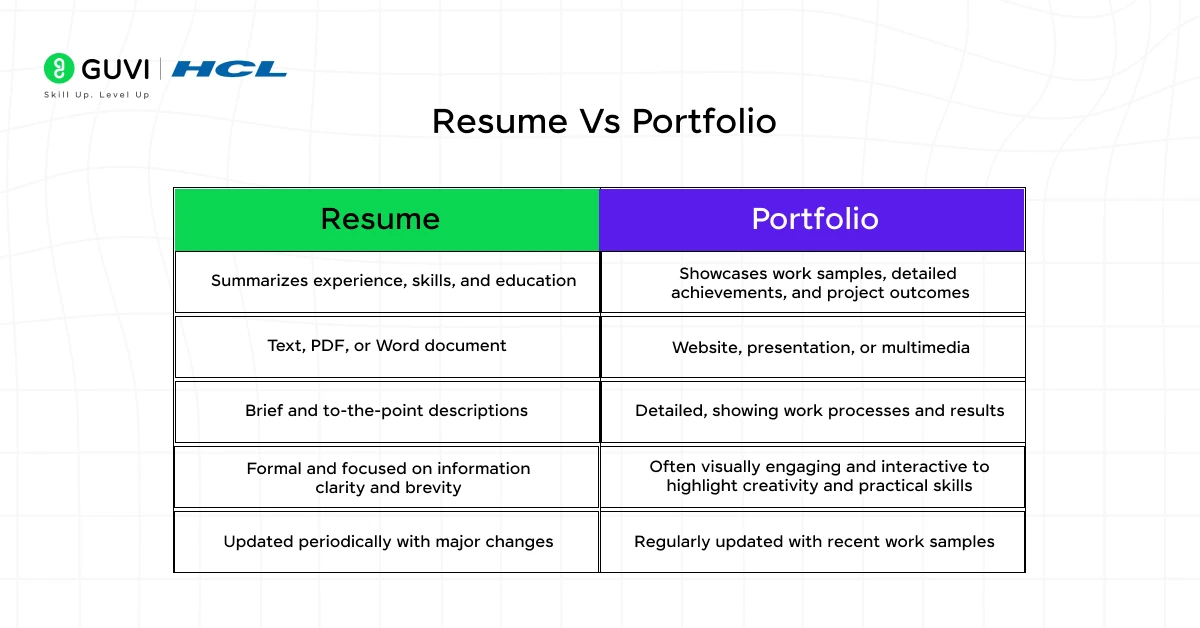
Creating A Digital Marketing Resume
As someone well-versed in digital marketing, who knows the craft inside out, it’s essential to showcase your skills the right way – starting with your resume. Your resume is more than just a document; it’s your personal marketing tool and it should reflect not only your expertise in areas like SEO, social media, and content strategy but also your ability to drive results and deliver value (All in less than a minute!)
In a field where first impressions matter, a well-crafted resume can set you apart from the competition and demonstrate your strategic thinking and creativity right from the start. And here are 5 essential tips that would create a solid digital marketing resume.
- Reverse chronological format
This has now become more than just a norm. A reverse chronological format is nothing but highlighting your most recent accomplishments first and moving forward to your past experiences and accomplishments. This matters a lot in your resume because we are living in a world where technological advancements in the marketing industry are constantly dominating the breaking news column, and when you are skilled with the latest technology and know your way around the digital marketing world by keeping up with the latest trends with solid results such as conversion rates, successful campaigns, etc – HIGHLIGHT them first and proceed to the rest moving forward.
- Quantify your achievements
“Vanity metrics are not important” is an ancient folklore and more than just a myth. In reality, these vanity metrics can often be solid proof and strong indicators that your strategies have worked.
Metrics like website traffic, social media engagement, or email open rates may seem overpromotional, but they can show tangible results that reflect your efforts.
These numbers help demonstrate that your strategies not only generated an initial buzz but also drove growth, whether through increased brand visibility, higher conversions, or enhanced customer engagement.
By quantifying your impact, you provide potential employers with concrete evidence of your ability to deliver results; something that words alone can’t capture.
- Use the keywords mentioned in the job description and postings
For someone with ample knowledge of how keywords work, we don’t need to stress their importance. However, it’s crucial to highlight the specific keywords mentioned in the job posting, such as “social media strategy,” “content marketing,” “SEO,” or “PPC management.” Tailoring your resume to reflect these keywords ensures that your skills are aligned with what the employer is looking for. Additionally, this strategy will help you pass through the screening process, which is often powered by Applicant Tracking Systems (ATS).
These systems scan resumes for specific terms to determine if your qualifications match the role, so using the right keywords increases your chances of making it to the next stage in the hiring process.
- Highlight relevant skills
If you are applying for a specific position in the digital marketing industry, such as copywriting or social media management, but are also well-versed in tools like Adobe Illustrator, email marketing platforms like Mailchimp, or skills such as data analysis, don’t hesitate to highlight them.
These additional skills can set you apart from other candidates by demonstrating your versatility and ability to contribute across multiple aspects of digital marketing. Showcasing these skills will not only make your resume stand out but will also position you as a well-rounded professional, capable of handling diverse tasks and adding more value to the role.
- Use active language
One of the common mistakes while creating a resume is using passive language, such as phrases like “was responsible for managing” or “helped with.” These phrases can make you sound detached from the actual impact of your work, as they don’t convey a sense of ownership or direct contribution. Instead, using active language with strong verbs like “led,” “created,” “optimized,” and “increased” demonstrates that you are a direct contributor, actively driving results and taking charge of key responsibilities.
This not only highlights your skills and achievements more effectively but also portrays you as an action-oriented, results-driven professional, making you stand out to employers.
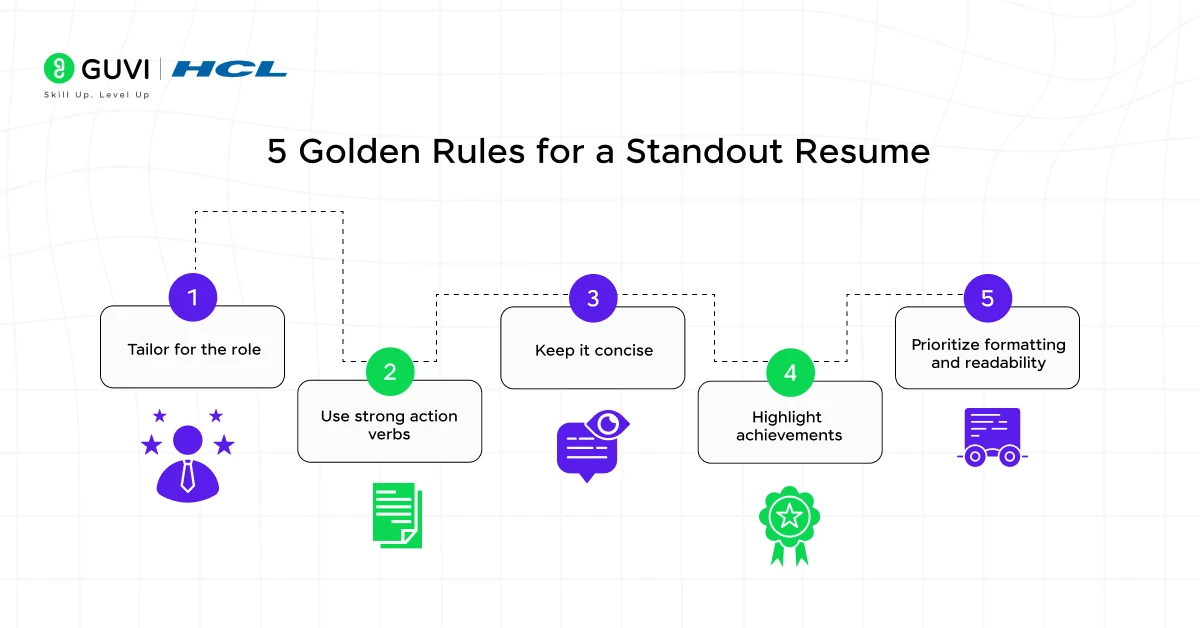
Key Elements to Include in your resume
1. Professional Summary
This includes a couple of lines that act as a brief, compelling summary indicating your experience in digital marketing, key skills, and what sets you apart.
Pro tip: Tailor it to the specific role you’re applying for.
2. Core Skills
List relevant digital marketing skills, such as SEO, SEM, content marketing, social media management, and tools learned. Make sure to include both technical and creative skills.
3. Work Experience
Highlight specific achievements and measurable outcomes, like increased website traffic, improved conversion rates, or successful campaigns.
4. Certifications and Training
Digital marketing is a field where continuous learning is crucial. Highlight any certifications you’ve earned from platforms like Google, HubSpot, or Facebook. These certifications show you’re committed to staying current in the industry.
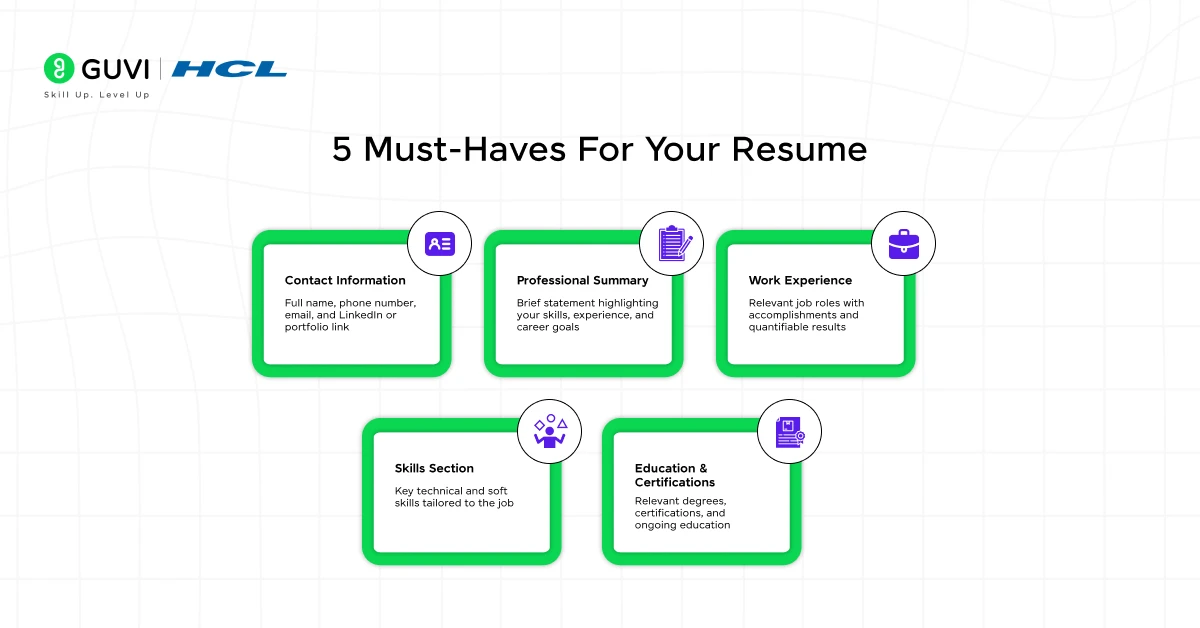
Creating a Digital Marketing Portfolio
While a resume can be like a movie trailer giving a quick glimpse of what you bring to the table, a portfolio is a full-feature film that dives deep into the story, showcasing the depth of your work and the results you’ve achieved.
If you have crossed the first level of impressing either your employer or a potential client with your resume or a basic pitch, kudos to you! Now, let’s focus on crafting your portfolio to grab that golden ticket.
Why is a digital marketing portfolio important?
Let’s keep it simple and crisp. There is an ample amount of career opportunities in the digital marketing industry and your digital marketing portfolio serves as the ultimate decision-maker for the employer or potential client. Effective digital marketing is the backbone of any business’s success, and if your portfolio showcases your best results clearly and convincingly, you won’t just be one of the candidates – you’ll be the one!
Key Elements to include in your digital marketing portfolio
- Quick Introduction
Start with a concise introduction about yourself, your expertise in digital marketing, and what makes you unique. Highlight how your approach delivers results.
Pro Tip: Avoid overusing “ME, ME, ME.” Focus on what you bring to the table and how you solve problems.
- Recent Work Samples
Showcase a curated selection of your most successful projects, emphasizing key metrics and results to demonstrate your impact.
Pro Tip: Include data-driven results to make a stronger case, such as “Increased website traffic by 50% in three months.”
- Contact Information
Ensure potential employers or clients can easily contact you by clearly displaying your email, phone number, and social media profiles.
Pro Tip: If you have a personal brand on social media that reflects your work, include those profiles.
- Testimonials
Add feedback from past clients or employers to build credibility and highlight your value.
Pro Tip: Use “before vs. after” stories to clearly show how you’ve improved a client’s business outcomes.
- Awards and Recognitions
Showcase industry accolades or achievements to set yourself apart from the competition. Mention recognitions that highlight your expertise and innovation.
- Certifications
Include relevant certifications like Google Analytics, HubSpot, or specialized tools that showcase your commitment to staying updated in the ever-evolving digital marketing landscape.
- Usage of Visuals
Words alone may not fully capture your expertise, thought process, and problem-solving journey in digital marketing. A visually compelling portfolio can bridge that gap. Incorporate charts, infographics, dashboards, and other visual elements to showcase your achievements and results effectively.
Pro Tip: Use visuals to highlight key metrics and insights.

How to Build a Digital Marketing Portfolio with No Experience
The best place to start if you have little to no experience is with your personal brand. Your personal brand reflects the quality of your work, your consistency, and how effectively you “build in public.” Sharing your insights through LinkedIn posts, blogs, or even video content on platforms like YouTube or Instagram can showcase your knowledge and creativity while building a credible online presence.
Another practical step is to volunteer with nonprofits or small businesses. Offering your digital marketing expertise in exchange for testimonials can provide valuable real-world experience and measurable results that will strengthen your portfolio.
If you lack professional work samples, highlight the certifications and online courses you’ve completed. This demonstrates your dedication to staying updated with industry trends and tools, showing employers or clients that you are prepared to contribute despite limited experience.
Additionally, consider creating a mock portfolio. For instance, if you’re a copywriter, craft mock campaigns for popular brands, create ad copies, email campaigns, or social media strategies. These samples can reflect your skills and understanding of industry needs, even if they aren’t tied to real-world results.
Building a portfolio from scratch may take time, but these steps will give you a strong foundation and the confidence to market your potential effectively!
3 Mistakes to Avoid While Creating Your Portfolio
1. Overcrowding with Too Much Information
Less is more when it comes to portfolios. Highlight only your best and most relevant work, as overloading it with excessive details can overwhelm and confuse your viewer.
2. Long Texts
Your employer or client will skim your portfolio, not read it line by line. Use concise descriptions and bullet points to ensure your key achievements stand out.
3. Including Irrelevant Details
Stick to work samples that align with your expertise. For instance, if you’re a graphic designer, including a blog post you wrote is unnecessary and distracts from your primary skill set.
Wrapping it all together
The average salary for a digital marketing manager in India ranges up to INR 18.5 Lakhs per year. As much as this can vary based on the location and years of experience, the growth in this industry is now skyrocketing.
A well-crafted resume and portfolio is non-negotiable and it is a great investment for your career. A perfect resume acts as the key to open doors, making that crucial first impression, and getting your foot in the door. On the other hand, a compelling portfolio takes it a step further – it builds trust, showcases your expertise, and helps you form lasting connections within your industry. Together, they create a powerful combination to demonstrate your value.
Remember, both your resume and portfolio should be dynamic and evolving. Regularly updating them ensures they reflect your latest achievements, skills, and growth. In an industry as competitive and constantly changing as digital marketing, staying relevant is the ultimate game-changer.
FAQ
1. Why is a Digital Portfolio Important?
A digital portfolio is essential because it provides tangible proof of your skills and achievements, helping you stand out from the competition.
2. How to Build a Digital Marketing Resume with No Experience?
Start by building your personal brand on social platforms, volunteering for small businesses or nonprofits, and earning relevant certifications.
3. How Can I Improve My Digital Portfolio?
Focus on quality over quantity, showcase measurable results, and include testimonials or feedback from past clients or mentors. Regularly update it with your latest achievements.
4. What Tools Should I Use to Create a Portfolio?
Use tools like Canva, Behance, WordPress, or Adobe Portfolio to design a visually appealing and professional portfolio tailored to your industry.
5. How Often Should I Update My Resume and Portfolio?
Ideally, update your resume and portfolio after completing any significant project, acquiring new skills, or achieving measurable results.

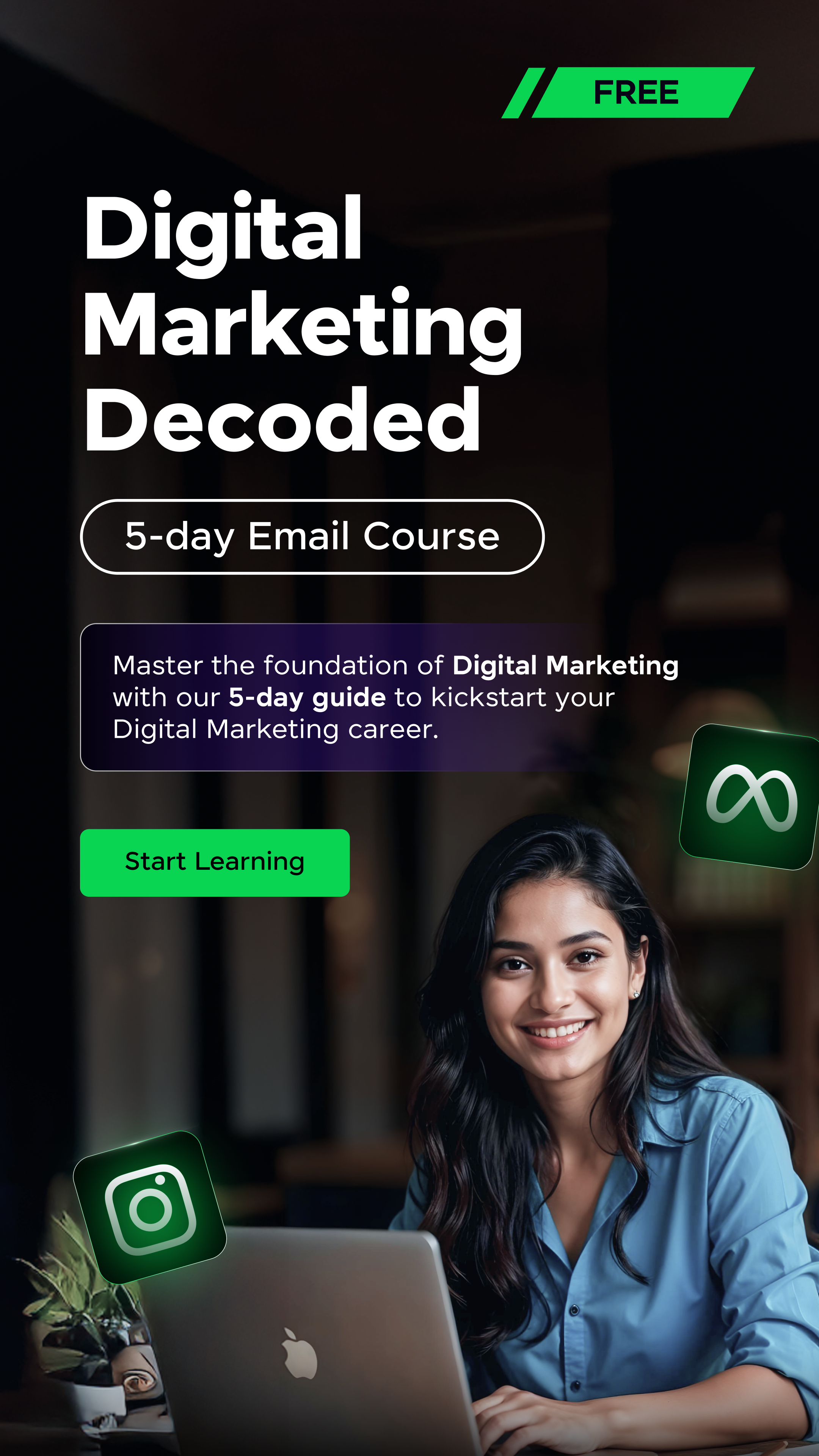





















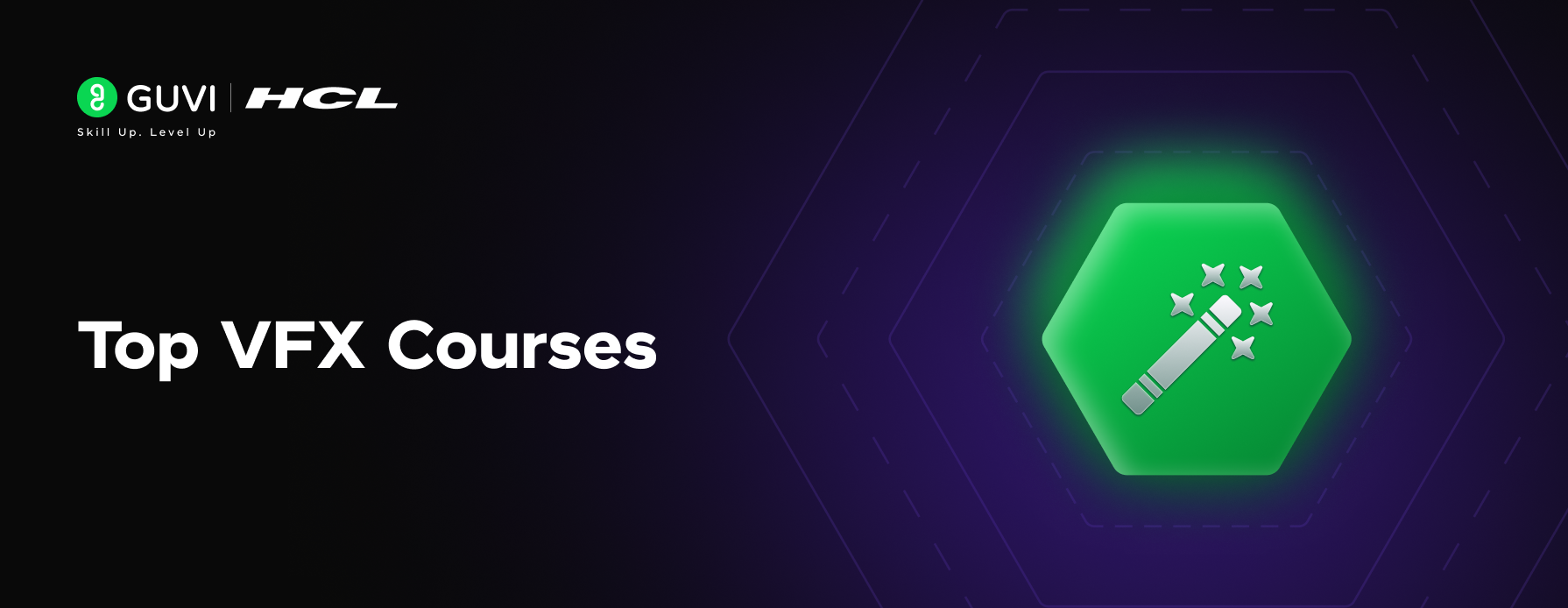
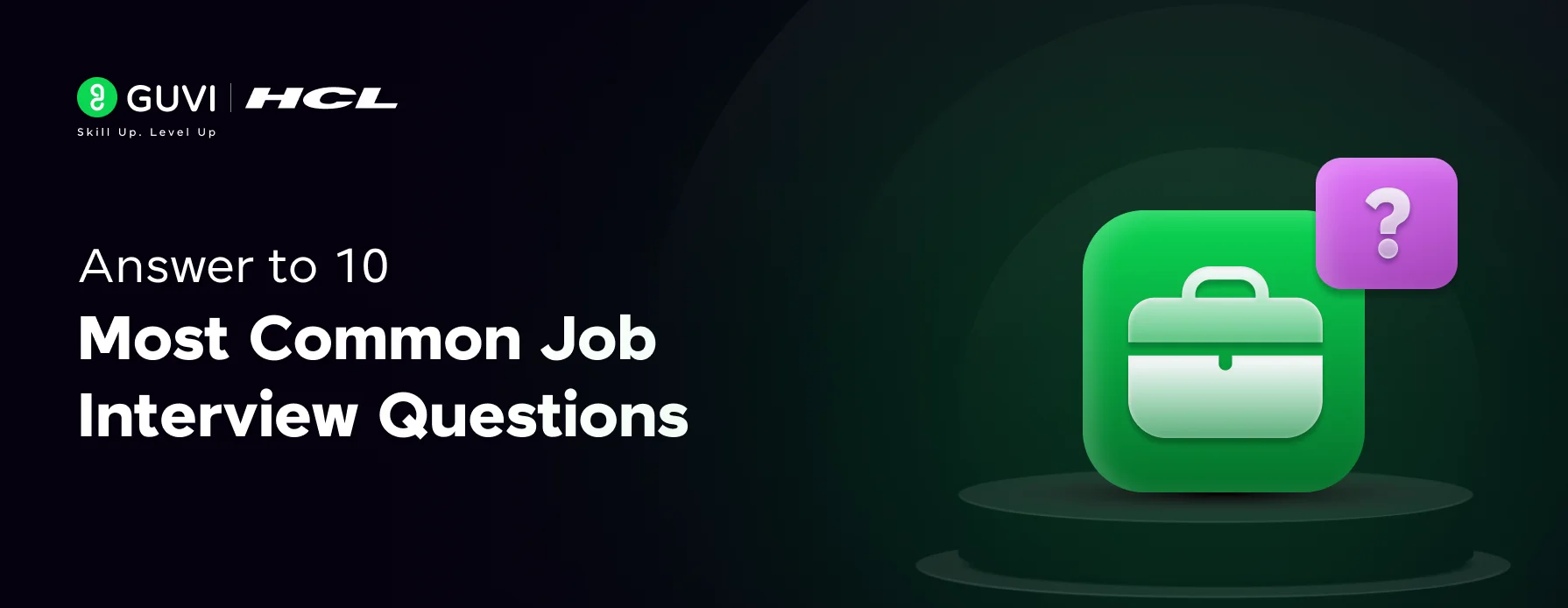






Did you enjoy this article?